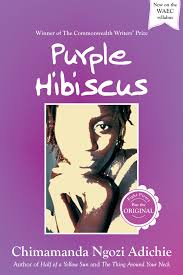I first read Purple hibiscus in 2012 when I was getting ready to write SSCE exam, it's an exam recognise in West Africa and Purple hibiscus was recommended.
Purple Hibiscus was written by Nigerian author Chimamanda Ngozi Adichie. It was published in 2003 and is her first book. The story examines themes of family, political unrest, religious fanaticism, and human growth while focussing on 15-year-old Kambili and her family in Nigeria. Against the backdrop of post-colonial Nigeria, the novel explores complex family dynamics, paying particular focus to Kambili's relationship with her authoritarian father and how she picks up new perspectives from her extended family.
Purple Hibiscus has won praise from critics for its character development, narrative, and examination of Nigerian political and cultural issues.
Exploring Themes of Freedom and Oppression in Chimamanda Ngozi Adichie’s Purple Hibiscus
Purple Hibiscus by Chimamanda Ngozi Adichie is a potent examination of personal autonomy, family dynamics, and the intricacies of Nigerian identity and culture. The story of 15-year-old Kambili Achike, whose family is kept together but suppressed by her father Eugene's strict supervision, is told in this post-colonial Nigerian novel. Through Kambili's perspective, the narrative explores the several types of oppression she encounters in her family and society at large, as well as the path she takes to find freedom and self-expression.
Complex Family Dynamics and Characterization
The complex familial structure that Adichie creates in Purple Hibiscus is among its most captivating features. Kambili's father, Eugene Achike, is a complicated person. He appears to be a well-respected businessman who is known for his charitable giving and strong Catholic beliefs. Eugene, on the other hand, is a severe and dictatorial man who pushes his family to practise intense religious piety at home. His aggressive acts, motivated by a distorted sense of morality, put Kambili, her brother Jaja, and their mother Beatrice in a claustrophobic situation.
Beatrice, Kambili's mother, is shown as being devoted but docile; she endures her husband's mistreatment and sets an example of silent suffering. She stands in for the numerous women who are ensnared in cycles of domestic abuse and are unable to escape because of fear or social expectations. Her eventual decision to poison Eugene and her slow unravelling throughout the book represent the breaking point that oppressed people occasionally experience after years of enduring.
Kambili’s Journey of Self-Discovery
In contrast, Kambili begins as a timid and afraid young woman who has been conditioned to follow and fulfil her father's wishes. She frequently finds it difficult to communicate openly or to show her feelings, illustrating how restrictive parenting stifles a child's voice and sense of value. Kambili encounters a world entirely distinct from her father's rigid home when she and her brother are forced to live with their liberal aunt, Ifeoma, and her kids. Kambili's view of family, religion, and individual freedom gradually shifts in this new setting, which is full of warmth, candid conversations, and laughing.
Aunt Ifeoma has a big impact on Kambili and Jaja by introducing them to a wider perspective on faith and life. Through Ifeoma, Adichie juxtaposes a more tolerant and caring interpretation of Catholicism with Eugene's harsh, dogmatic interpretation. Although Ifeoma is pious, she supports the right to free speech and encourages her kids to think critically and ask questions. This contrast demonstrates how religion may be harmful when used as a weapon of control but can also be consoling and enlightening when embraced honestly.
Symbols of Rebellion and Freedom
The book makes good use of symbols to examine rebellion and independence. One of the most obvious symbols is the purple hibiscus flower that Aunt Ifeoma grows in her garden. This flower, which represents originality and resilience, flourishes in a society where limitations and conformity are the norm, in contrast to the typical red hibiscus. According to Kambili, the purple hibiscus symbolises the courage to embrace freedom and depart from the confining circumstances her father has created. Jaja's personal enlightenment and eventual rebellion against his father are symbolised by the flower.
The figurines that Beatrice, Kambili's mother, cherishes serve as another emblem in the book. Beatrice's inner existence and her efforts to remain composed and in control despite her husband's assault are symbolised by these fragile figures. A pivotal moment in the book occurs when Eugene brutally burns these figurines, signifying the devastation of Beatrice's soul and her ultimate choice to confront Eugene in the only way she believes is feasible.
The Broader Social and Political Context
Despite its emphasis on private and domestic matters, Purple Hibiscus also captures Nigeria's larger social and political unrest. Adichie uses allusions to a corrupt government and the legacy of colonialism to put the story against a backdrop of political unrest. Adichie criticises the impact of Western religion and ideals on Nigerian society through characters such as Eugene. Eugene exemplifies the nuanced effects of colonialism on both national and individual identity through his stern dedication to Catholicism and rejection of native Nigerian traditions.
The work also depicts the repression of free expression and Nigeria's fight for democracy. The Nigerian people live under a harsh regime, just like Kambili and her family do under Eugene's dictatorial leadership. Adichie crafts a potent allegory of Nigeria's struggles and the global fight for freedom and self-expression by reflecting these societal difficulties in the Achike family dynamics.
Conclusion: A Testament to Resilience
In the end, Purple Hibiscus is a tale of tenacity and the bravery to take back one's identity and voice. Adichie examines the many ways people fight oppression and seek liberation via Kambili's journey and the connections that mould her. Together with her mother and brother, Kambili's eventual rise from her father's shadow represents hope and the potential for recovery. In her first book, Adichie tells a timeless tale of development, defiance, and the quest for individual freedom that is both intensely personal and representative of Nigeria's larger cultural and political environment.


